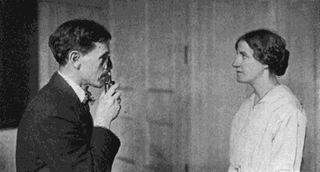
Glasses, also known as eyeglasses or spectacles, are devices consisting of glass or hard plastic lenses mounted in a frame that holds them in front of a person's eyes, typically using a bridge over the nose and arms which rest over the ears.

A contact lens, or simply contact, is a thin lens placed directly on the surface of the eye. Contact lenses are considered medical devices and can be worn to correct vision, or for cosmetic or therapeutic reasons. In 2004, it was estimated that 125 million people worldwide use contact lenses, including 28 to 38 million in the United States. In 2010, the worldwide market for contact lenses was estimated at $6.1 billion, while the US soft lens market was estimated at $2.1 billion. Multiple analysts estimated that the global market for contact lenses would reach $11.7 billion by 2015. As of 2010, the average age of contact lens wearers globally was 31 years old, and two-thirds of wearers were female.

Near-sightedness, also known as short-sightedness and myopia, is an eye disorder where light focuses in front of, instead of on, the retina. This causes distant objects to be blurry while close objects appear normal. Other symptoms may include headaches and eye strain. Severe near-sightedness increases the risk of retinal detachment, cataracts, and glaucoma.

Sunglasses or sun glasses are a form of protective eyewear designed primarily to prevent bright sunlight and high-energy visible light from damaging or discomforting the eyes. They can sometimes also function as a visual aid, as variously termed spectacles or glasses exist, featuring lenses that are colored, polarized or darkened. In the early 20th century, they were also known as sun cheaters.

The Bates method is an alternative therapy aimed at improving eyesight. Eye-care physician William Horatio Bates, M.D. (1860–1931) attributed nearly all sight problems to habitual strain of the eyes, and felt that glasses were harmful and never necessary. Bates self-published a book, Perfect Sight Without Glasses, as well as a magazine, Better Eyesight Magazine, detailing his approach to helping people relax such "strain", and thus, he claimed, improve their sight. His techniques centered on visualization and movement. He placed particular emphasis on imagining black letters and marks, and the movement of such. He also felt that exposing the eyes to sunlight would help alleviate the "strain".

A diving mask is an item of diving equipment that allows underwater divers, including scuba divers, free-divers, and snorkelers, to see clearly underwater. Surface supplied divers usually use a full face mask or diving helmet, but in some systems the half mask may be used. When the human eye is in direct contact with water as opposed to air, its normal environment, light entering the eye is refracted by a different angle and the eye is unable to focus the light on the retina. By providing an air space in front of the eyes, the eye is able to focus nearly normally. The shape of the air space in the mask slightly affects the ability to focus. Corrective lenses can be fitted to the inside surface of the viewport or contact lenses may be worn inside the mask to allow normal vision for people with focusing defects.

Presbyopia is a condition associated with the aging of the eye that results in progressively worsening ability to focus clearly on close objects. Symptoms include difficulty reading small print, having to hold reading material farther away, headaches, and eyestrain. Different people will have different degrees of problems. Other types of refractive errors may exist at the same time as presbyopia.

An eyeglass prescription is an order written by an eyewear prescriber, such as an optometrist or ophthalmologist, that specifies the value of all parameters the prescriber has deemed necessary to construct and/or dispense corrective lenses appropriate for a patient. If an examination indicates that corrective lenses are appropriate, the prescriber generally provides the patient with an eyewear prescription at the conclusion of the exam.

Refractive eye surgery is an eye surgery used to improve the refractive state of the eye and decrease or eliminate dependency on glasses or contact lenses. This can include various methods of surgical remodeling of the cornea (keratomileusis), lens implantation or lens replacement. The most common methods today use excimer lasers to reshape the curvature of the cornea. Successful refractive eye surgery can reduce or cure common vision disorders such as myopia, hyperopia and astigmatism, as well as degenerative disorders like keratoconus.

Intraocular lens (IOL) is a lens implanted in the eye as part of a treatment for cataracts or myopia. The most common type of IOL is the pseudophakic IOL. These are implanted during cataract surgery, after the cloudy eye's natural lens has been removed. The pseudophakic IOL provides the same light focusing function as the natural crystalline lens. The second type of IOL, more commonly known as a phakic intraocular lens (PIOL), is a lens which is placed over the existing natural lens and is used in refractive surgery to change the eye's optical power as a treatment for myopia (nearsightedness).

Refractive error, also known as refraction error, is a problem with focusing light accurately onto the retina due to the shape of the eye. The most common types of refractive error are near-sightedness, far-sightedness, astigmatism, and presbyopia. Near-sightedness results in far away objects being blurry, far-sightedness and presbyopia result in close objects being blurry, astigmatism causes objects to appear stretched out or blurry. Other symptoms may include double vision, headaches, and eye strain.
Orthokeratology, refers to the use of gas permeable contact lenses that temporarily reshape the cornea to reduce refractive errors such as myopia, hyperopia and astigmatism. This method can be used as an alternative to eyeglasses, refractive surgery, or for those who prefer not to wear contact lenses during the day. Orthokeratology is most often used for candidates with up to -6.00 diopters of myopia, though exceptions may be made if the prescription is only slightly lower.

An eye examination is a series of tests performed by an ophthalmologist, optometrist, or orthoptist, optician (UK), assessing vision and ability to focus on and discern objects, as well as other tests and examinations pertaining to the eyes. Health care professionals often recommend that all people should have periodic and thorough eye examinations as part of routine primary care, especially since many eye diseases are asymptomatic.
Emmetropia is the state of vision where a faraway object at infinity is in sharp focus with the eye lens in a neutral or relaxed state. This condition of the normal eye is achieved when the refractive power of the cornea and the axial length of the eye balance out, which focuses rays exactly on the retina, resulting in perfect vision. A human eye in a state of emmetropia requires no corrective lenses; the vision scores well on a visual acuity test. For example, on a Snellen chart test, emmetropic eyes score at "6/6"(m) or "20/20"(ft) vision, meaning that at a distance of 20 ft they see as well as a normal eye at a distance of 20 ft. Either myopic (near-sighted) eyes or hyperopic (far-sighted) eyes would score worse, e.g. 20/40. A person with exceptionally acute vision might score at 20/15.
Retinal migraine is a retinal disease often accompanied by migraine headache and typically affects only one eye. It is caused by ischaemia or vascular spasm in or behind the affected eye.
The eye, like any other optical system, suffers from a number of specific optical aberrations. The optical quality of the eye is limited by optical aberrations, diffraction and scatter. Correction of spherocylindrical refractive errors has been possible for nearly two centuries following Airy's development of methods to measure and correct ocular astigmatism. It has only recently become possible to measure the aberrations of the eye and with the advent of refractive surgery it might be possible to correct certain types of irregular astigmatism.
















